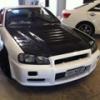Oil Control In Rb's For Circuit Drag Or Drift
Announcements
-
Similar Content
-
Latest Posts
-
If that's the wiring from the factory, I'd be inspecting the loom everywhere. Any signs of that anywhere else, and seriously, I'd get rid of the car ASAP before the electrical gremlins make it worthless, or it goes up in flames on its own. That is scary how that insulation is failing!
-
By welshy_32ZILA · Posted
I should note too as I have all 4 wheel speed inputs to the emtron I now have the emtron controlling the attessa solenoid for 4wd/traction and launch control strategies. -
By welshy_32ZILA · Posted
It works quite well with the adjustibility within each of the programs of the turbolamik. Essentially p1 is drive and lockup comes on like a normal driver. But in program 7 I have customised it to not request the lockup clutch to engage until something like 6500/7 when slip was the lowest. -
Yep, I like that. The tags are only on the first post of a thread and we don't get huge numbers of new threads. Also, I plan to add some more report types and we could have a member report type like 'review tags' then members could flag if they thought a topic wasn't tagged correctly. No way man, I dig the input. Thanks!
-
It's a valid thought. There's not exactly that functionality already (when creating a thread) - that's where the OP can use/create any tag they want. We'd have to come up with a way for the user to request their tags get reviewed or something. Otherwise the mods would have to review every new post's tags (for those that have them, anyway). There's kind of that functionality already exists to some extent, post facto of starting the thread, where the OP or any other user could report the post to admins, and request that tags get reviewed. We could do this already, and any user could already have made such a request. To make it a part of the forum proper, it would require an initial and an ongoing education programme, so that people know that it's a thing. OP based tagging/request for review would also require at least some (probably most) of the user base to be told that it's a thing they can do. Both of these things probably wouldn't spread too far and/or get used very much. If it was the standard approach on a lot of different sites, then it might do, because people would be used to it. Prank's approach to this differs from my original thought, by leaning into tagging. Which is fine - it's possibly better than what I originally suggested. In fact, I just went to the R32 GTR wiring diagram thread and added tags, including "Library". That's probably a good way to use tags and the idea of a library. We just have to drag together an (organised!) index of threads or posts that have that tag. I have yet to do any of my own follow up by pursuing worthy threads and posts and reporting/marking/tagging them for the library, such as the @Sydneykid stuff I was talking about, and possibly any amount of @Lithium 's and others' posts. At least if I tag them Library, we'll have a start. Back to @Wazmond's idea as it relates to @PranK's, we might have some sort of a list of tags that are already used to scrape for this library. I'm not entirely sure how that would be presented or used, particularly if it got long. But it's yet another idea! cheers
-







Recommended Posts
Create an account or sign in to comment
You need to be a member in order to leave a comment
Create an account
Sign up for a new account in our community. It's easy!
Register a new accountSign in
Already have an account? Sign in here.
Sign In Now